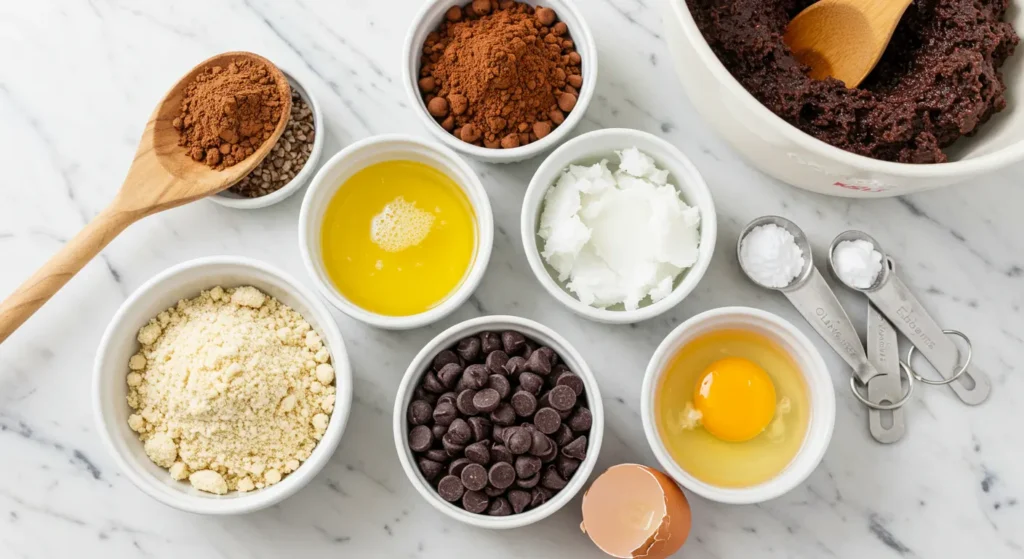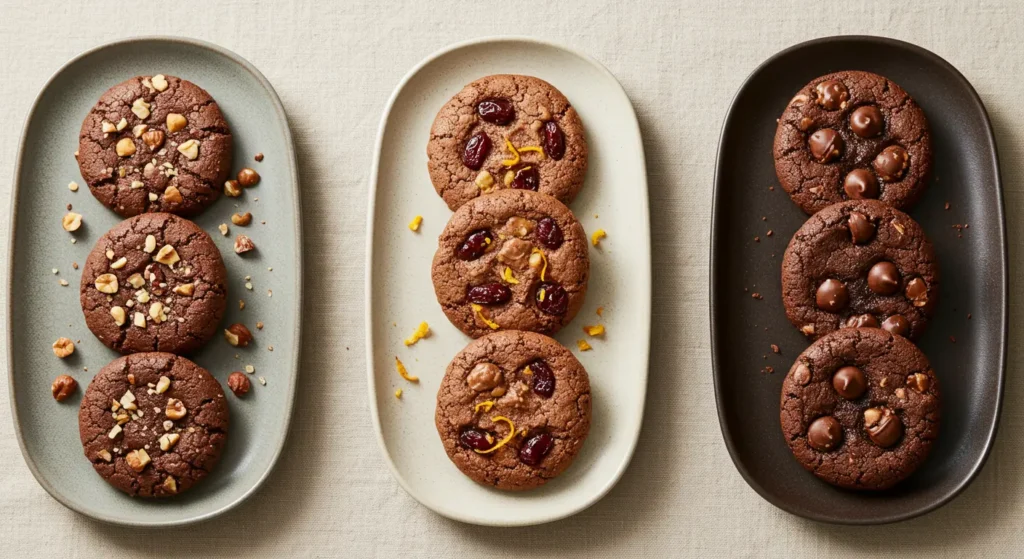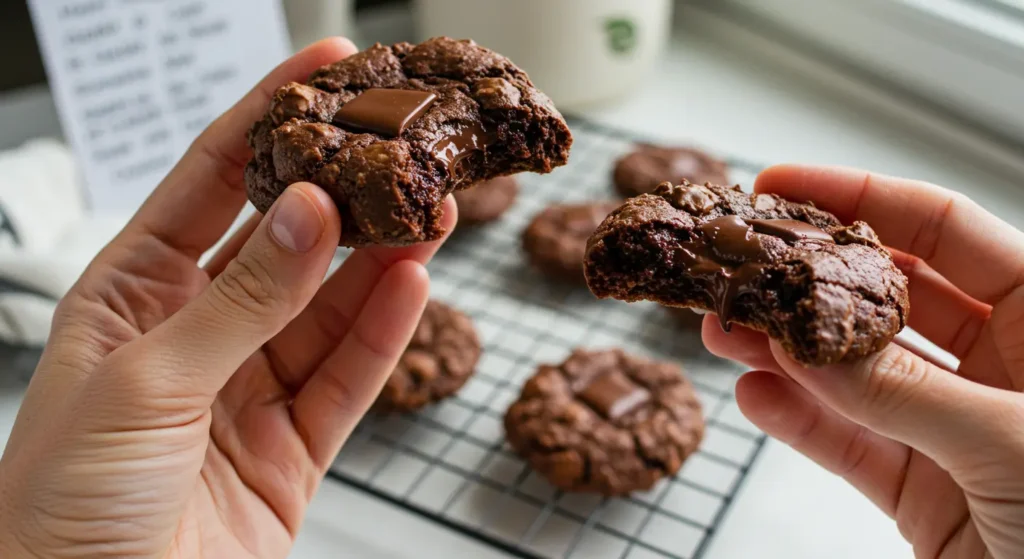Healthier Chocolate Cookies – Why This Recipe?
Growing up in a household where desserts were both a passion and a tradition, I always found myself gravitating toward chocolate cookies. However, as I developed my culinary expertise as Chef Greeny, I began to recognize the importance of creating treats that satisfy our cravings without compromising our health goals. That’s when my journey to perfect healthier chocolate cookies began.
My grandmother used to say that a good cookie should bring joy with every bite, and I believe that joy shouldn’t come with guilt attached. These healthier chocolate cookies represent the culmination of years experimenting with wholesome ingredients that maintain the decadent flavor and satisfying texture we all crave from traditional chocolate cookies.
What makes these cookies special is their perfect balance – they deliver that rich chocolate experience while incorporating nutrient-dense ingredients and reducing refined sugars. Whether you’re managing dietary restrictions, seeking more nutritious snack options, or simply want to enjoy a better-for-you treat, these cookies will transform your perception of what “healthy” baking can taste like.
In this post, you’ll learn how to create irresistible healthier chocolate cookies, understand the nutritional benefits of key ingredient swaps, explore the fascinating history behind chocolate cookies, and discover variations to suit different dietary needs. Let’s dive into creating chocolate indulgence you can feel good about!
Healthier Chocolate Cookies – Ingredients and Preparation
Ingredients List

Dry Ingredients:
- 1¼ cups almond flour
- ⅓ cup unsweetened cocoa powder
- ½ teaspoon baking soda
- ¼ teaspoon sea salt
- ½ cup dark chocolate chips (70% cacao or higher)
Wet Ingredients:
- ⅓ cup coconut oil, melted (or avocado oil)
- ⅓ cup maple syrup (or honey)
- 1 large egg (room temperature)
- 1 teaspoon vanilla extract
Optional Add-ins:
- ¼ cup chopped walnuts or pecans
- 2 tablespoons chia seeds
- 1 tablespoon ground flaxseed
Substitutions for Dietary Restrictions:
- Gluten-free: This recipe is naturally gluten-free with almond flour
- Vegan: Replace egg with a flax egg (1 tablespoon ground flaxseed + 3 tablespoons water, mixed and set for 5 minutes)
- Nut-free: Use oat flour instead of almond flour (may need to adjust quantity slightly)
- Sugar-free: Use monk fruit sweetener or stevia-based maple syrup alternative
Step-by-Step Instructions
- Prepare your workspace and ingredients: Preheat your oven to 350°F (175°C) and line a baking sheet with parchment paper. Bring the egg to room temperature if you haven’t already. Chef’s Tip: Room temperature eggs blend more evenly with other ingredients, leading to a better cookie texture.
- Mix dry ingredients: In a medium bowl, whisk together the almond flour, cocoa powder, baking soda, and salt until well combined and no cocoa powder lumps remain. Chef’s Tip: Sifting the cocoa powder prevents lumps and ensures even chocolate distribution.
- Prepare wet ingredients: In a separate large bowl, mix the melted coconut oil, maple syrup, egg, and vanilla extract until smooth and well incorporated. Chef’s Tip: If your coconut oil solidifies when it meets the cold ingredients, gently warm the mixture for a few seconds.
- Combine wet and dry mixtures: Gradually add the dry ingredients to the wet ingredients, stirring until just combined. Be careful not to overmix. Chef’s Tip: Overmixing can lead to tough cookies—stop mixing as soon as no dry flour is visible.
- Add mix-ins: Fold in the dark chocolate chips and any optional add-ins you’ve chosen. Chef’s Tip: Reserve a few chocolate chips to press into the tops of the cookies before baking for a professional bakery look.
- Form the cookies: Using a tablespoon or cookie scoop, drop rounded portions of dough onto the prepared baking sheet, leaving about 2 inches between each cookie. Gently flatten each cookie with the back of a spoon (they won’t spread much during baking).
- Bake to perfection: Place in the preheated oven and bake for 8-10 minutes until the edges are set but the centers still appear slightly soft. Chef’s Tip: These healthier cookies can overbake quickly! They’ll continue firming up after removal from the oven, so it’s better to underbake slightly than overbake.
- Cool properly: Allow the cookies to cool on the baking sheet for 5 minutes before transferring to a wire rack to cool completely. Chef’s Tip: The texture improves as they cool, so resist sampling immediately (though I know it’s tempting!).
Notes and Tips

Storage Tips:
- Store in an airtight container at room temperature for up to 3 days
- Refrigerate for up to 1 week
- Freeze for up to 3 months (place parchment paper between layers)
Serving Suggestions:
- Pair with unsweetened almond milk or oat milk for a balanced treat
- Crumble over Greek yogurt with berries for a healthier dessert option
- Sandwich two cookies with a thin layer of almond butter for a protein boost
Make-Ahead Instructions:
- Prepare the dough up to 24 hours in advance and refrigerate
- Form cookie dough balls and freeze on a tray, then transfer to a freezer bag for ready-to-bake cookies anytime (add 2-3 minutes to baking time when baking from frozen)
Healthier Chocolate Cookies – Nutritional Information
Nutrition Facts (Per Serving)
Based on recipe yielding 12 cookies, one cookie per serving
| Nutrient | Amount |
|---|---|
| Calories | 165 |
| Carbohydrates | 14g |
| Protein | 3g |
| Total Fat | 12g |
| Saturated Fat | 6g |
| Unsaturated Fat | 5g |
| Trans Fat | 0g |
| Fiber | 3g |
| Sugar | 8g |
| Cholesterol | 15mg |
| Sodium | 95mg |
These healthier chocolate cookies provide significant nutritional advantages over traditional chocolate cookies, including:
- Higher fiber content: The almond flour and optional add-ins like chia seeds contribute to nearly triple the fiber of standard cookies
- Better fats: Using coconut oil and nuts provides beneficial fats rather than processed shortenings
- Reduced refined sugar: Natural sweeteners like maple syrup have a lower glycemic impact
- Added nutrients: Dark chocolate contains antioxidants, while nuts and seeds add vitamins and minerals
Healthier Chocolate Cookies – History and Cultural Significance
The chocolate cookie has a rich history dating back to the 1930s when Ruth Wakefield accidentally invented the chocolate chip cookie at her Toll House Inn. What began as an improvisation—chopping a chocolate bar into a cookie recipe expecting it to melt completely—became an American culinary icon.
Traditional chocolate cookies typically rely heavily on refined flours, sugars, and fats. The movement toward healthier chocolate cookies emerged in the early 2000s as part of a broader wellness trend and growing awareness of nutritional considerations. This evolution represents our desire to maintain cultural food traditions while adapting them to modern health knowledge.
Across cultures, we see similar trends in cookie evolution:
- In Italy, traditional biscotti have seen healthier adaptations with alternative flours and reduced sugars
- Middle Eastern date cookies often swap refined sugars for natural fruit sweetness
- Asian bean-based cookies have influenced Western recipes looking for lower-glycemic alternatives
The healthier chocolate cookie represents a beautiful cultural intersection: honoring the joy and tradition of beloved recipes while embracing nutritional wisdom that helps us care for our bodies.
Healthier Chocolate Cookies – Creative Variations
Protein-Packed Chocolate Cookies
Perfect for post-workout treats or for those seeking to increase their protein intake:
- Add ¼ cup unflavored or chocolate protein powder to the dry ingredients
- Reduce almond flour by 2 tablespoons to maintain proper consistency
- Mix in 1 tablespoon of Greek yogurt to the wet ingredients for moisture
- Consider adding 1 tablespoon of almond butter for richness and additional protein
- Bake for 9-11 minutes (slightly longer than the original recipe)
Nutritional impact: Increases protein to approximately 6g per cookie, making it a more balanced snack option.
Mediterranean-Inspired Chocolate Olive Oil Cookies
For a heart-healthy twist with complex flavor notes:
- Replace coconut oil with high-quality extra virgin olive oil
- Add 1 teaspoon of orange zest to the wet ingredients
- Mix in 2 tablespoons of chopped dried cherries or cranberries
- Sprinkle with a tiny pinch of sea salt flakes before baking
- Reduce baking time by 1 minute for a slightly softer center
Nutritional impact: Increases monounsaturated fats and provides additional antioxidants from olive oil, citrus, and dried fruit.
Adapting to Different Dietary Needs
Creating inclusive desserts is important for bringing people together. Here are adaptation principles for common dietary requirements:
Keto-Friendly:
- Replace maple syrup with liquid monk fruit sweetener or erythritol
- Use 100% cacao chocolate chips or chopped unsweetened chocolate
- Add 1 tablespoon of MCT oil for energy and texture
Paleo:
- Ensure all ingredients are unprocessed
- Use honey instead of maple syrup if preferred
- Add 1 tablespoon of coconut flour for texture
Low-FODMAP:
- Verify cocoa powder is free from additives
- Choose dark chocolate with minimal additives
- Skip any high-FODMAP add-ins like honey (use maple syrup instead)
Healthier Chocolate Cookies – Frequently Asked Questions

Can I freeze these healthier chocolate cookies?
Yes, these cookies freeze exceptionally well! For best results, cool them completely first, then place in a single layer on a baking sheet to freeze for 1-2 hours. Once frozen, transfer to an airtight container or freezer bag with parchment paper between layers. They’ll keep for up to 3 months. Thaw at room temperature for about 30 minutes before enjoying, or warm briefly in a 300°F oven for that fresh-baked experience.
What can I substitute for almond flour if I have a nut allergy?
If you have a nut allergy, oat flour makes an excellent substitute. You can purchase it pre-made or make your own by processing rolled oats in a food processor until fine. Use the same amount as called for almond flour, though you might need to adjust slightly as oat flour absorbs more moisture. Another option is sunflower seed flour, which behaves similarly to almond flour in recipes. For those with multiple allergies, a gluten-free all-purpose flour blend can work, though you may need to add an extra tablespoon of oil to prevent dryness.
How long does it take to prepare these cookies from start to finish?
The total time investment for these healthier chocolate cookies is approximately 25-30 minutes:
- 10-12 minutes for measuring and mixing ingredients
- 3-5 minutes for forming the cookies
- 8-10 minutes for baking
- 5 minutes for cooling
The active preparation time is only about 15 minutes, making these an achievable weeknight treat. For even faster preparation, measure out your dry ingredients ahead of time and store them in a labeled container.
Can I reduce the sugar further without affecting the texture?
You can reduce the sweetener by up to 25% (to about ¼ cup maple syrup) without significantly impacting the texture. To maintain sweetness while reducing sugar further, try:
- Adding ¼ teaspoon of pure stevia extract
- Including naturally sweet add-ins like chopped dates or ripe banana (½ mashed)
- Enhancing perceived sweetness with ¼ teaspoon of cinnamon or a pinch of cardamom
Remember that some sweetener is necessary for proper moisture and binding in the recipe.
Healthier Chocolate Cookies – Final Thoughts
Creating healthier versions of classic favorites doesn’t mean sacrificing flavor or the joy of baking. These healthier chocolate cookies prove that with thoughtful ingredient selection, we can honor our bodies while still indulging our taste buds. The rich chocolate flavor, satisfying texture, and nutritional improvements make these cookies a smarter choice for everyday treats.
What I love most about this recipe is its versatility. Whether you’re preparing snacks for children, accommodating various dietary needs at a gathering, or simply wanting to enjoy chocolate cookies without derailing your wellness goals, this recipe provides a flexible foundation for delicious possibilities.
Remember that “healthier” doesn’t mean “perfect” – and that’s not the goal. These cookies represent a balanced approach to eating well while still embracing life’s pleasures. Food is not just fuel; it’s connection, tradition, and joy. By making mindful adjustments to beloved recipes, we create space for both nutrition and pleasure.
I encourage you to try these healthier chocolate cookies and make them your own. Experiment with add-ins that speak to your preferences, adjust sweetness to your taste, and share them with people you care about. After all, the best recipes are those that evolve through our personal touches and shared experiences.
Leave a comment with your favorite variation or a photo of your cookie creation! What ingredient swap made the biggest difference for you?
Learn more about the history of chocolate cookies on Wikipedia


1 thought on “7 Incredible Healthier Chocolate Cookies That Will Satisfy Your Sweet Tooth”